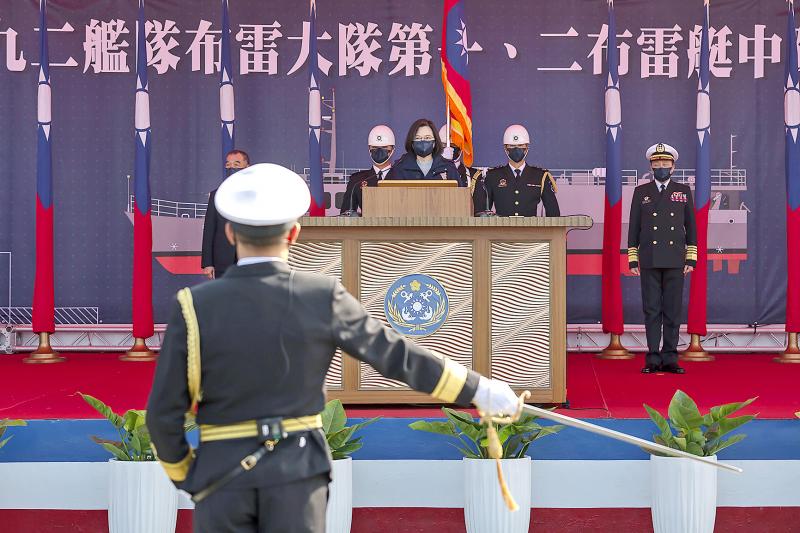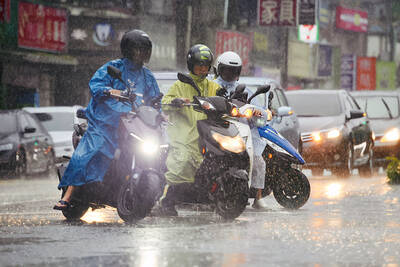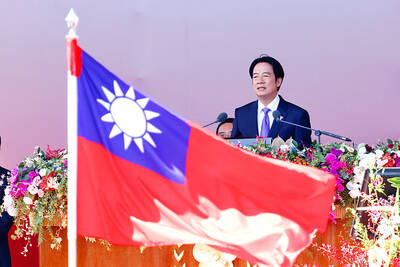The navy yesterday established its first two minelaying squadrons, each armed with one minelayer, at the Zuoying Naval Base in Kaohsiung.
“These are the first minelaying squadrons established by the Republic of China Navy,” President Tsai Ing-wen (蔡英文) said at a ceremony to mark the formation of the first and second minelaying squadrons under the 192nd Fleet. “I am glad we are able to witness this important moment together.”
Tsai said that the newly established forces show Taiwan’s achievement in building up its domestic defense industry and commitment to safeguarding the nation.

Photo: Taiwan Presidential Office via AP
The navy allocated NT$917.77 million (US$33.22 million) from 2017 to last year to build four rapid minelaying ships with the aim of enhancing Taiwan’s mine deployment capacity to better counter enemy threats.
Taiwanese manufacturer Lungteh Shipbuilding said that each minelayer is 41m long and 8.8m wide, and has a draft of 1.607m with a full-load displacement of 315 tonnes.
The minelayers are each armed with a T-75 20mm cannon on the bow, and a T-74 7.62mm machine gun and three mine-laying tracks on each side. The vessels are also equipped with an automatic mine-laying system developed by the Chungshan Institute of Science and Technology.
The ships, which can carry different types of mines, were delivered before the end of last year, but only two were put into active service yesterday.
The navy previously placed mines in the sea using landing ships, but that was not efficient and also potentially dangerous in choppy waters, Tsai said.
The minelayers built by Lungteh and equipped with the institute’s system would enable the navy to lay mines more efficiently and accurately, she said.
The Naval Fleet Command said the minelaying forces were established as part of the Ministry of National Defense’s efforts to bolster the nation’s asymmetric defense capabilities.
The new forces can collaborate with allies to jointly deter and delay the landing of enemy forces, it said.
Institute for National Defense and Security Research analyst Su Tzu-yun (蘇紫雲) said that mines are “cheap and highly effective denial weapons” that can disrupt an enemy’s advance and force their vessels to alter planned routes.
They can be also used in conjunction with anti-ship missiles to strengthen the country’s defense, he added.

The combined effect of the monsoon, the outer rim of Typhoon Fengshen and a low-pressure system is expected to bring significant rainfall this week to various parts of the nation, the Central Weather Administration (CWA) said. The heaviest rain is expected to occur today and tomorrow, with torrential rain expected in Keelung’s north coast, Yilan and the mountainous regions of Taipei and New Taipei City, the CWA said. Rivers could rise rapidly, and residents should stay away from riverbanks and avoid going to the mountains or engaging in water activities, it said. Scattered showers are expected today in central and

People can preregister to receive their NT$10,000 (US$325) cash distributed from the central government on Nov. 5 after President William Lai (賴清德) yesterday signed the Special Budget for Strengthening Economic, Social and National Security Resilience, the Executive Yuan told a news conference last night. The special budget, passed by the Legislative Yuan on Friday last week with a cash handout budget of NT$236 billion, was officially submitted to the Executive Yuan and the Presidential Office yesterday afternoon. People can register through the official Web site at https://10000.gov.tw to have the funds deposited into their bank accounts, withdraw the funds at automated teller

COOPERATION: Taiwan is aligning closely with US strategic objectives on various matters, including China’s rare earths restrictions, the Ministry of Foreign Affairs said Taiwan could deal with China’s tightened export controls on rare earth metals by turning to “urban mining,” a researcher said yesterday. Rare earth metals, which are used in semiconductors and other electronic components, could be recovered from industrial or electronic waste to reduce reliance on imports, National Cheng Kung University Department of Resources Engineering professor Lee Cheng-han (李政翰) said. Despite their name, rare earth elements are not actually rare — their abundance in the Earth’s crust is relatively high, but they are dispersed, making extraction and refining energy-intensive and environmentally damaging, he said, adding that many countries have opted to

PEACE AND STABILITY: Maintaining the cross-strait ‘status quo’ has long been the government’s position, the Ministry of Foreign Affairs said Taiwan is committed to maintaining the cross-strait “status quo” and seeks no escalation of tensions, the Ministry of Foreign Affairs (MOFA) said yesterday, rebutting a Time magazine opinion piece that described President William Lai (賴清德) as a “reckless leader.” The article, titled “The US Must Beware of Taiwan’s Reckless Leader,” was written by Lyle Goldstein, director of the Asia Program at the Washington-based Defense Priorities think tank. Goldstein wrote that Taiwan is “the world’s most dangerous flashpoint” amid ongoing conflicts in the Middle East and Russia’s invasion of Ukraine. He said that the situation in the Taiwan Strait has become less stable